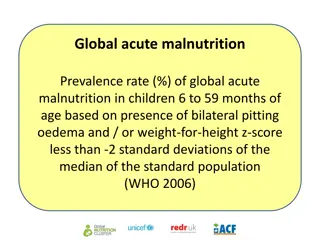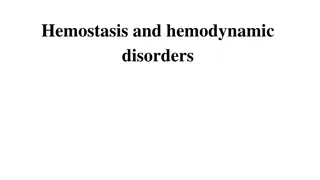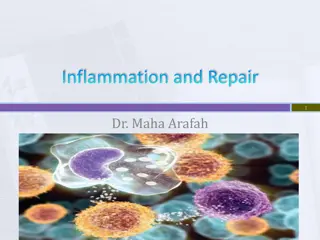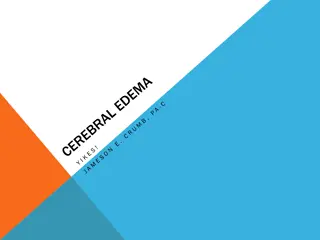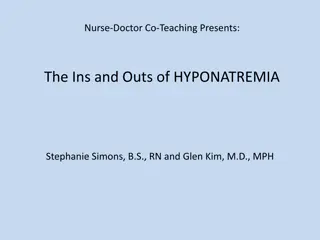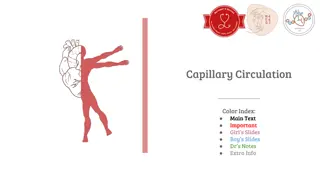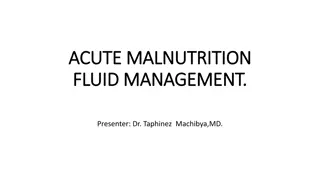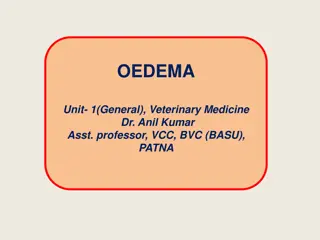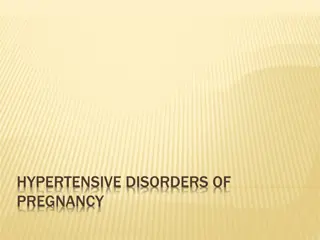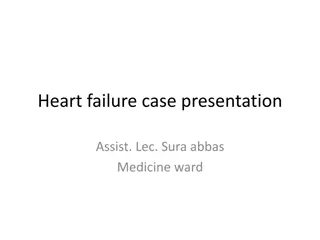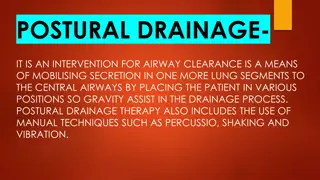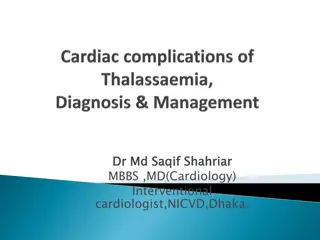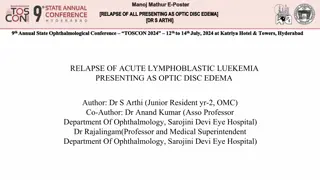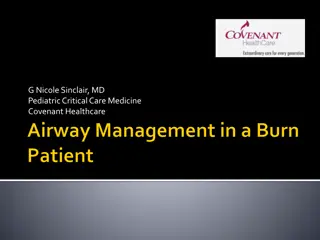
Edema: Causes, Mechanisms, and Management
Learn about edema, an excessive accumulation of interstitial fluid in the body, its representation, causes, and effects on effective arterial volume. Explore the mechanisms behind edema development, including factors such as capillary pressure, oncotic pressure, and endothelial damage. Discover key hormones and peptides involved in regulating fluid balance and vascular tone. Gain insights into the classification and approach to managing edema effectively.
Download Presentation

Please find below an Image/Link to download the presentation.
The content on the website is provided AS IS for your information and personal use only. It may not be sold, licensed, or shared on other websites without obtaining consent from the author. If you encounter any issues during the download, it is possible that the publisher has removed the file from their server.
You are allowed to download the files provided on this website for personal or commercial use, subject to the condition that they are used lawfully. All files are the property of their respective owners.
The content on the website is provided AS IS for your information and personal use only. It may not be sold, licensed, or shared on other websites without obtaining consent from the author.
E N D
Presentation Transcript
Edema is represented by an excess of interstitial fluid which has becpme clinically evident Total body water : 1/3 extracellular & 2/3 intracellular Extracellular compartment: 25 % intravascular 75 % extravascular Fluid volume is normally maintained by starlings forces
Net movement of fluid from intravascular to interstitium occurs in : Increase in capillary hydrostatic pressure Reduction in plasma oncotic pressure Increase in interstitial oncotic pressure Capillary endothelial barrer damage Inadequate lymphatic drainage
Effective arterial volume is reduced in many forms of edema Diminished renal flow Renin release from jg cells Acts on angiotensinogen (liver) Release Angiotensin 1(decapeptide) Angiotensin 2 (octapeptide)
All have generalised vasoconstrictor properties Decreases hydrostatic pressure in peritubular capillaries,increases oncotic pressure in these vessels enhanced salt and water reabsorption from pct and ascending limb of loop of henle Increased aldosterone production
ARGININE VASOPRESSIN : released by posterior pituitary in response to increased intracellular osmolar concentration (v2 receptors) ENDOTHELIN : Increased in severe heart failure: renal vasoconstriction and sodium retention ANP & BNP : produced by atrial distension & increase in ventricular diastolic pressure respectively causing i) excretion of sodium and water ii)dilation of arterioles and venules but not sufficiently potent to prevent edema
CLASSIFICATION OF EDEMA Based on site of involvement : localised/generalised based on type: exudative / transudative Clinically : pitting / nonpitting
CAUSES OF GENERALISED EDEMA Cardiac Hepatic Renal Drug induced Edema of nutritional origin
CAUSES OF LOCALISED EDEMA VENOUS EDEMA 1) Deep vein thrombosis 2) varicose veins/ivc obstruction 3) svc/ivc obstruction 4) May thurners syndrome LYMPHATIC EDEMA 1)Chronic lymphangitis 2)Resection of regional lymph nodes 3)Filariasis 4)Radiotherapy 5)congenital(milroys) INFLAMMATORY CAUSES : cellulitis
GENERALISED EDEMA CARDIAC ORIGIN Symptoms : exertional dyspnoea,orthopnoea,pnd Physical examination : elevated jvp s3 gallop peripheral cyanosis,cool extremities small pulse pressure Lab investigations : eleated urea nitrogen:creatinine ratio decreased sodium elevated natriuretic peptides
GENERALISED EDEMA :RENAL CAUSES Symptoms: usually chronic might be associated with uremic symptoms dyspnoea less prominent than heart failure Physical examination : Elevated BP hypertensive/diabetic retinopathy nitrogenous fetor pericardial friction rub
LAB FINDINGS IN EDEMA OF RENAL ORGIN S.creatinine,serum cystatin elevation Albuminuria Hyperkalemia Metabolic acidosis Hyperphosphatemia Hypocalcemia anemia
EDEMA OF HEPATIC ORGIN HISTORY : dyspnea uncommon,except with significant ascites Examination : ascites normal jvp bp lower than renal or cardiac disease chronic liver disease stigmata Lab findings: decreased serum albumin,cholesterol,fibrinogen,transferrin Elevated liver enzymes Tendency towards hypokalemia Respiratory alkalosis Macrocytosis from folate deficiency
DRUGS CAUSING EDEMA Nsaids Antihypertensives Direct arterial vasodilators :hydralazine,clonidine,methyldopa,minoxidil,guanethidine Calcium channel antagonists Alpha adrenergic antagonists Thiazolidinedione Steroids :glucocorticoids/anabolic steroids/estrogen/progesterone Cyclosporine Growth hormone Immunotherapies:il2/okt3 monoclonal antibody
LOCALISED EDEMA LOWER LIMB EDEMA CAN BE 1) UNILATERAL i)acute ii)chronic 2) BILATERAL i)acute ii)chronic
ACUTE CAUSES OF UNILATERAL EDEMA DVT evidence of dvt : calf tenderness pain or firmness along courseof a vein unilateral warmth/erythema larger circumference of calf in affected leg :most useful finding homans sign : not reliable
No evidence of dvt : 1)CELLULITIS : Warmth and redness skip areas usually associated with constitutional symptoms 2) SUPERFICIAL THROMBOPHLEBITIS : Palpable,tender superficial veins 3) POPLITEAL (BAKERS) CYST : Calf symptoms usually occur when cyst ruptures distinguished from dvt by1) posterior knee pain 2)knee stiffness 3)swelling behind the knee ( prominent on knee extension) Compression of popliteal veins : leg swelling/secondary dvt
CALF MUSCLE PULL OR TEAR : History of inciting injury,signs of bleeding (usg) bruising at the ankle may be presnt MAY THURNERS SYNDROME :young females(2nd or 3rd decade) acute pain and swelling over entire lower extremity with or without thrombosis compression of left iliac vein between right common iliac artery and 5th lumbar vertebra INFLAMMATORY PATHOLOGY OF THE KNEE : Pain and swelling accompany kneejoint pathology can mimic dvt / popliteal cyst
CHRONIC UNILATERAL PEDAL EDEMA Most common cause : chronic venous insufficiency Other less common causes: primary/secondary lymphedema , pelvic neoplasms,complex regional pain syndrome Findings if not consistent with above causes : COMPRESSION ULTRASONOGRAPHY WITH DOPPLER Can Confirm chronic venous disease Normal study: lymphedema/complex regional pain syndrome Pelvic outflow obstruction : neoplasm : ovarian/endometrial/bladder/lymphoma/prostate cancer
BILATERAL PEDAL EDEMA acute chronic b/l dvt Chronic venous disease Acute heart failure Pulmonary hypertension Acute renal/liver failure Heart/renal/liver disease Ivc thrombosis Chronic ivc occlusion/ivc aplasia/hypoplasia Ivc tumours Lymphedema Drugs Obesity/nutritional b/l infection Malabsorption/hypoalbuminemia Thyroid Obstructive sleep apnoea
INVESTIGATION : Urine dipstick-for protein serum creatinine serum albumin prothrombin time liver function tests thyroid-stimulating hormone If these tests are unrevealing we obtain an echocardiogram to evaluate the possibility of heart failure or pulmonary hypertension. If echo also unrevealing most probably chronic venous disease -pigmentary changes, induration, and ulceration typical skin findings of chronic venous disease are absent, we obtain imaging of the pelvis to exclude a pelvic neoplasm or other lesion-causing venous outflow obstruction Eg TVS , CECT of pelvis
LYMPHOEDEMA Not a true edematous state. The major causes of lymphedema in adults in developed countries are axillary lymph node dissection in patients with breast cancer and axillary or inguinal lymph node dissection in patients with melanoma. Worldwide, the most common cause is filariasis. The edema is typically limited to an arm or leg. The clinical hallmark of lymphedema is the presence of cutaneous and subcutaneous thickening, as manifested by cutaneous fibrosis, peau d orange, and a positive Stemmer sign, which refers to an inability to tent the skin at the base of the digits.



